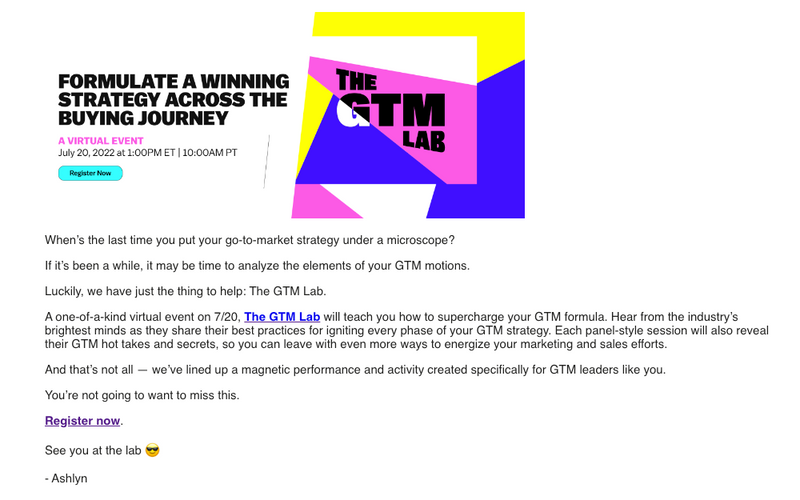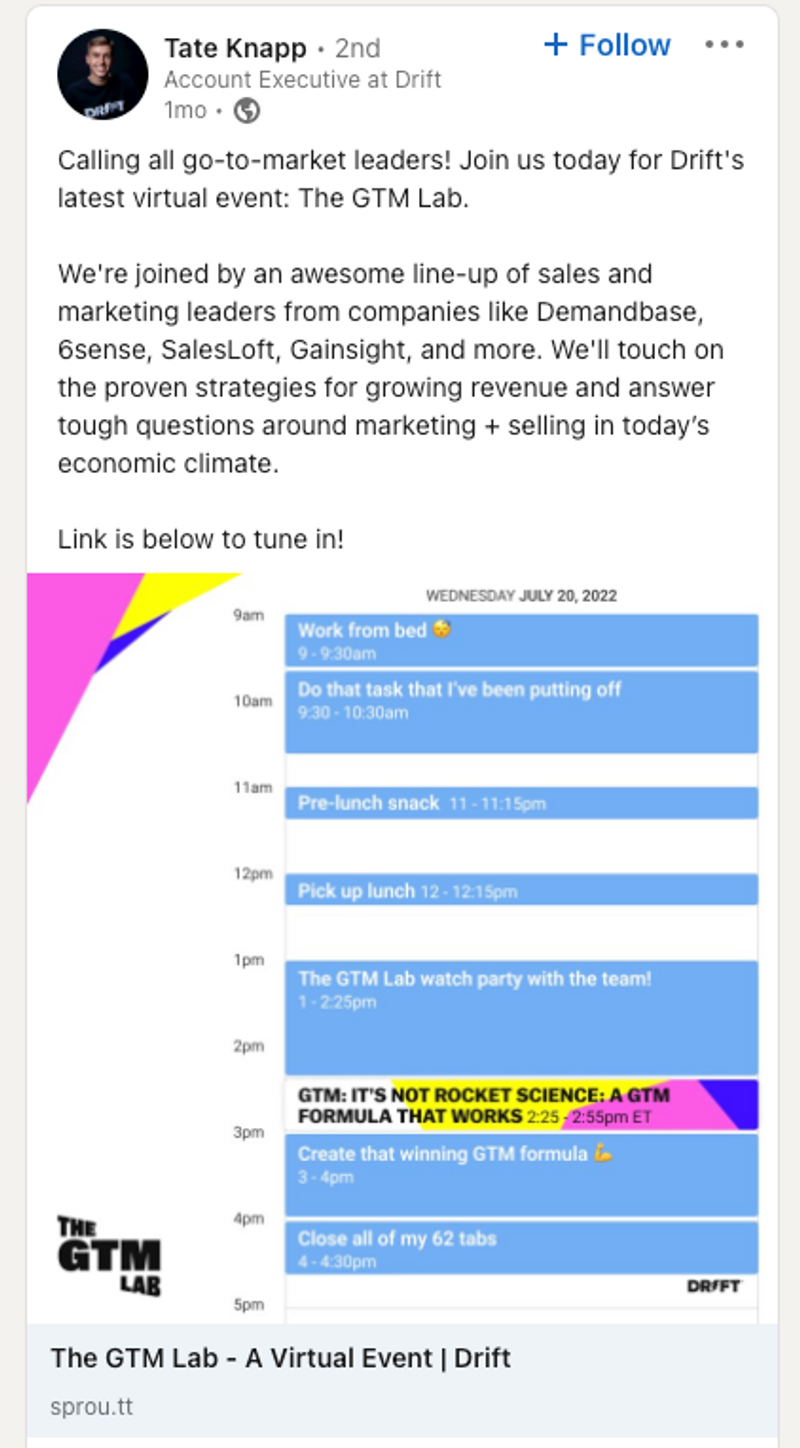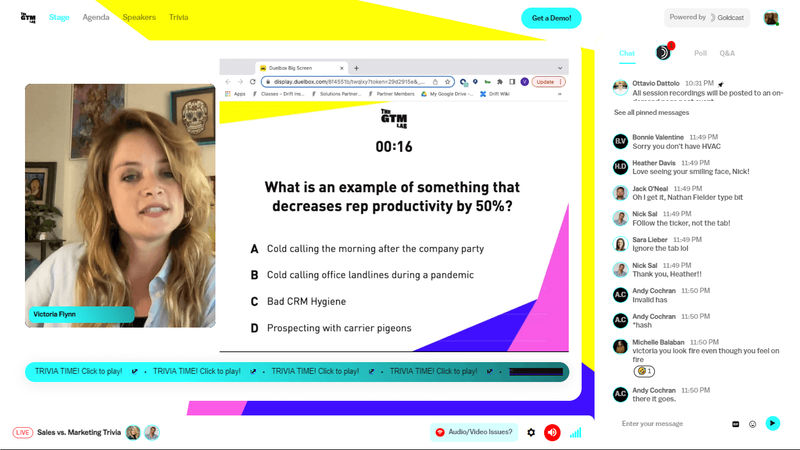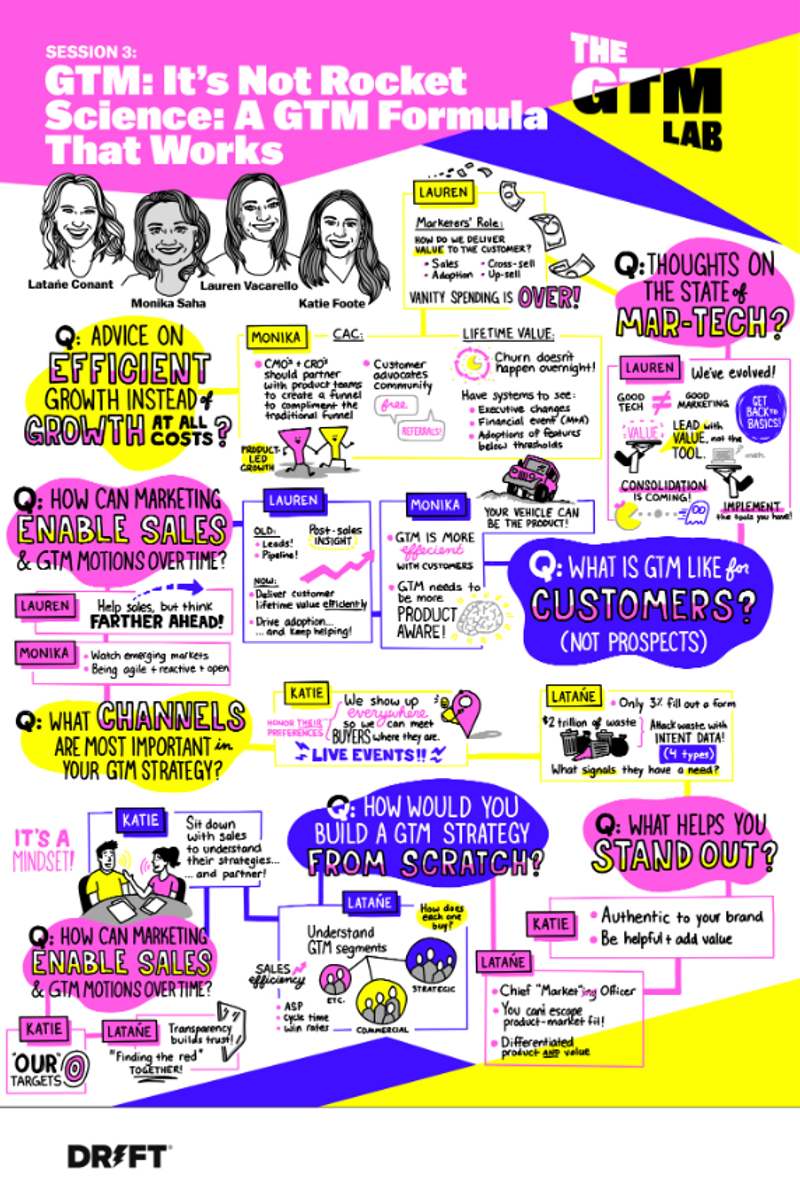Driving Registrations and Revenue With Conversational Event Marketing

Maximize Your Marketing ROI
Join 10,000 other marketers already getting the best tips on running engaging events that boost pipeline and create raving fans.
According to Drift, 80% of marketers have moved their face-to-face events either partially or fully to a digital platform—and many don’t see this as a short-term change.
We’ve fully embraced this shift here at Goldcast and are always looking for clever and creative ways to elevate our event experience.
That’s why we partnered with Sara Lieber, Event Marketing Manager at Drift, for a chat about how Conversational Marketing tactics can be applied to Event Marketing.
If you know anything about Drift, you know that they’ve re-invented the way companies engage with audiences through the concept of Conversational Marketing. But what is “conversational marketing,” and how can it apply to Event Marketing?
We tackled that and so much more with specific examples from Drift’s recent GTM Lab event. Check out the full webinar on-demand and our top takeaways below. 👇
Conversational marketing meets event marketing 🤝
Sara started by explaining why the “traditional” way of doing business is broken.
Here’s how companies want their websites to work: Someone (from an unknown channel) visits the website. They’re so impressed with what they see that they immediately fill out a contact form to learn more. From there, they’re blown away in their first conversation with sales and immediately convert into a paying customer. Voila!
However, this simply isn’t how real humans operate. People buy from people, and the path is far from linear.
Enter: Conversational Marketing. This dialogue-driven approach to marketing uses real-time interactions to engage site visitors and accelerate them through the buying journey. It creates an authentic experience that builds relationships and trust with customers and buyers.
While this concept can apply to other marketing channels, we focused our conversation on events.
Here’s a quick recap of how you can personalize your event marketing and enable conversations before, during, and after your event—with plenty of examples from Drift’s recent GTM Lab event.
Starting conversations before an event
The main goals tracked before an event include awareness and registrations. Are the right people learning about your event? And are they signing up to join?
In a recent PathFactory and Heinz Marketing report, only 27% of marketers said their company was effective at generating registrations. Yikes!
If this resonates with you, Drift has a few tips to help.
First, consider your promotion schedule. You’ll definitely want to let your audience know you're having an event, but you don't want to oversaturate them with communication or spam their inbox with too many invites. Simply blasting your entire list is a quick way to lose subscribers.
For their recent GTM Lab event, Drift used a highly segmented email strategy. They identified a few key personas that aligned with their event sessions and personalized all promo, confirmation, and reminder emails.

Sara is a big proponent of branded messaging (think a dedicated event logo, bespoke colors, etc.) versus a plain text HTML email for event promotions. Your header should highlight the event, and the copy should be conversational—not generic.
Having these unique elements in your communications for every event will help it to stand out and reflect your brand’s unique personality.
Social media was another huge tool for Drift. They leveraged their own brand account but also tapped employees, speakers, and partners to help spread the word. The flashy branded graphics really stood out on timelines and having real humans recommend the event built trust.

Drift also has a handy hack for driving registrations. They implement custom event playbooks for chatbots across their site that engage with relevant personas. These bots can live anywhere on your site, not just on the event registration page. This is a fantastic way to get in front of the right people at the right time and promote an event at scale.
⚡️ Here are the top metrics to watch pre-event:
- # of registrations
- Page views
- Opens/clicks
Enabling conversations during an event
Once you've made some great connections and have a solid registration roster for your event, you must keep the momentum going and enable conversations during the event.
In the same report from PathFactory and Heinz Marketing, only 44% of marketers said they have an effective strategy for engaging with audiences in real-time. However, companies with high event attendance reported using multiple digital engagement strategies.
Engagement is the name of the game during events. Drift likes to leverage multiple engagement tactics to keep attendees active and engaged.
First, start each session with an icebreaker to get folks chatting. It's a nice way to loosen things up and allow attendees to share a little bit about themselves. At Goldcast, our favorite prompt is “where are you tuning in from.” It truly works!
Prompt the chat early and often, and make sure you have a moderator behind the scenes responding and answering questions. Drift had a dedicated teammate working the event behind the scenes for each session.
If your platform allows, use things like polls, live video Q&A, etc., to engage the audience directly. These allow attendees to interact with the speaker and content directly.
To make the event more interactive, you can add games or other fun things that may align with the overall event content. These little ‘surprise and delight’ moments mimic the engaging elements you would have in an in-person event.
It's important to customize the options in line with the type of event you're hosting. There is no one method that works. You can integrate multiple options and give people the chance to engage the way they want to with the event.
See what resonates the most with your audience and change things up from time to time. The point is to foster engagement and keep people tuned into your event and consuming your content.
Drift notices that the more engagement opportunities they offer, the more folks tend to engage.
You can also call out entertainment breaks in between to conduct quizzes, host entertainers, etc. During the last GTM Lab event, Drift hosted a trivia session live on stage with multiple-choice questions and gave away gifts to the top scorers.

They also had a live ‘sales rapper’ for one of the breaks. Attendees could drop phrases or words in the chat, and he rapped on them in real-time. You can experiment with similar small sessions to provide some light relief during your event.
⚡️ Top metrics to watch during an event:
- Real-time attendance
- Session attendance
- Chat conversations
- Social engagement
Continuing conversations after an event
The work doesn’t stop after the cameras stop rolling. The post-event work is arguably the most important stage of the process, and no one knows this better than Drift.
Drift uses Marketo to track the status of each registrant (attended vs not-attended) and all of their in-event activity. They then sync this data with Salesforce so that each account executive (AE) has a full view of their contacts’ activities. They also have alerts set up so that AEs know when their accounts are active in an event.
Sara shared that Drift is very intentional when planning post-event activities. Post-event follow-up is often a hot topic across teams. At Drift, Marketing owns this motion through the Sales Development team, which uses thoughtful segmentation for any outreach.
For example, people who registered and attended get a much different email than folks who registered and did not attend. And high-intent accounts get even further customization and 1:1 outreach from the person working their account.
In addition to the event recording, the team curates helpful resources that are relevant to each segment and offers plenty of opportunities to keep the conversation going. For the GTM Lab event, Drift had a sketch artist do recaps in graphics for every session.

They then sent out a folder of all the graphics to all attendees, which served as a reminder of each session’s top takeaways. In a best-case scenario of post-event buzz, several attendees even shared the graphics across social media. Talk about cool and creative!
While this level of personalization does take extra work on the front end, the results are well worth the extra effort.
And remember, it’s important not to treat it as simply a sales pitch. The point of follow-ups is not to spam people, but to be helpful and foster a conversation. If that conversation leads to a demo, that's great. However, you may end up just helping someone, and that's great too!
⚡️ Top post-event metrics to watch:
- Pipeline generated/influenced
- # of future customers (opportunities)
- # / $ of closed-won deals
- # / $ of expansions
- # of interested people (MQLs)
- # of scheduled conversations (demos/meetings)
- # of held conversations (demos held/meetings held)
–
Thanks so much for joining us, Sara! If you’ve made it this far and you like what you’ve read, check out Drift’s GTM Lab event on-demand.

Transform Your Video Marketing with AI
Stay In Touch
Platform
Resources
© 2025 Copyright Goldcast, Inc. All rights reserved.





 Upcoming Events
Upcoming Events Event Series
Event Series On-Demand Events
On-Demand Events

